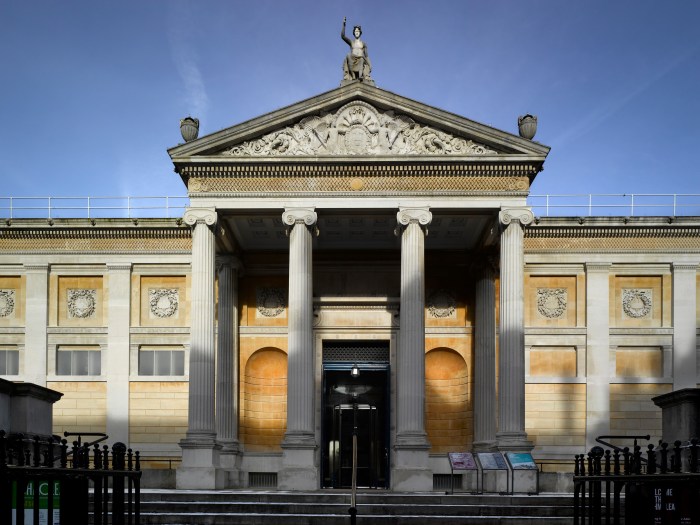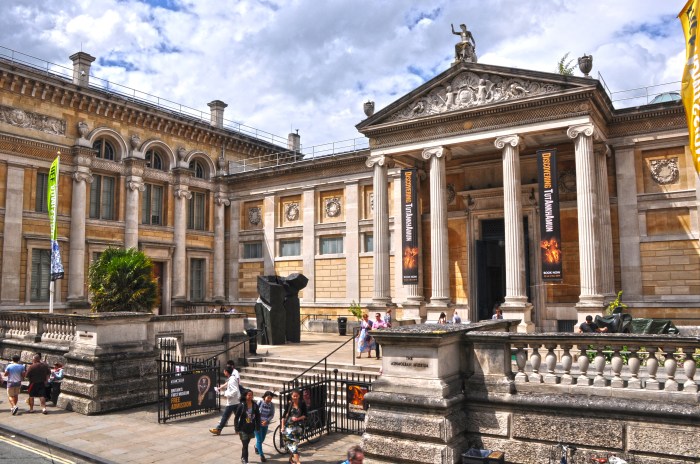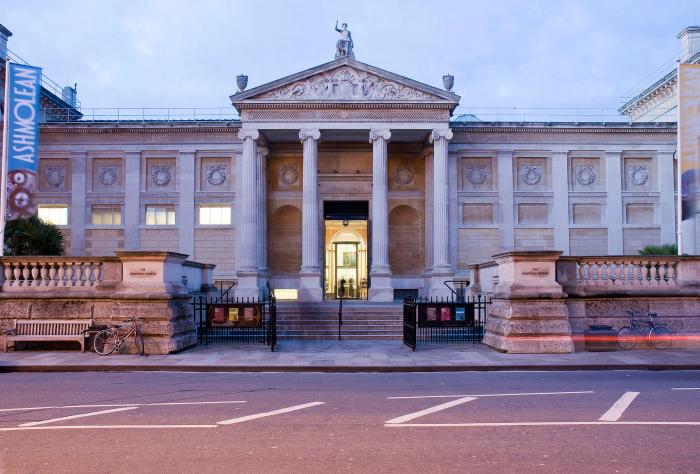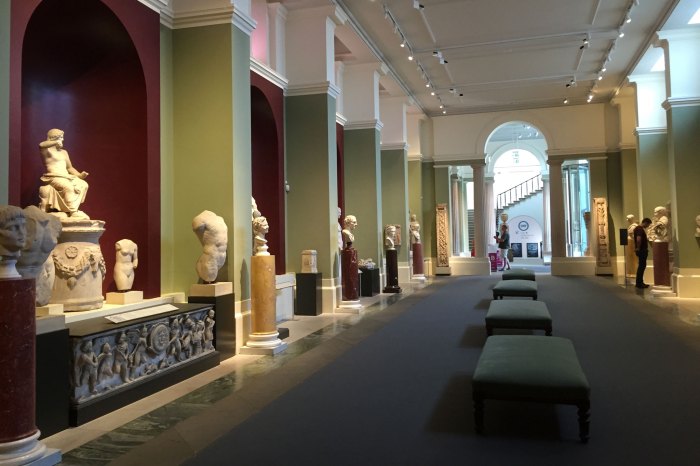The Ashmolean Museum, a beacon of art and history in the heart of Oxford, invites you on a captivating journey through time and cultures. Founded in the 17th century, this esteemed institution has played a pivotal role in shaping England’s artistic and archaeological landscape.
Within its hallowed halls, the Ashmolean Museum houses an unparalleled collection of artifacts and artworks that span civilizations and epochs. From the enigmatic Rosetta Stone to the exquisite Elgin Marbles, each piece tells a compelling story of human ingenuity and creativity.
Historical Significance

The Ashmolean Museum, established in 1683, is one of the oldest and most renowned museums in the world. Its foundation marked a pivotal moment in the development of art and archaeology in England.
One of the must-visit destinations in Oxford, England, is the Ashmolean Museum. The museum houses a vast collection of art and artifacts from around the world, including paintings, sculptures, and archaeological finds. If you’re planning a trip to Europe in 2024, consider adding the Ashmolean Museum to your itinerary.
You can find more information about the museum and other top travel destinations for 2024 at best travel destinations 2024. The Ashmolean Museum is a great place to learn about different cultures and see some of the world’s most famous works of art.
The museum owes its existence to Elias Ashmole, an antiquarian and collector who donated his vast collection of artifacts, books, and curiosities to the University of Oxford. Ashmole’s collection formed the core of the museum’s initial holdings, which included a diverse range of objects from ancient Egypt, Greece, and Rome.
Role in the Development of Art and Archaeology
The Ashmolean Museum played a crucial role in fostering the study of art and archaeology in England. It provided a platform for scholars to research and interpret the museum’s collection, leading to significant advancements in the fields of classical archaeology, Egyptology, and art history.
- The museum’s collection of classical sculptures and artifacts inspired artists and architects during the 18th and 19th centuries, contributing to the development of neoclassical styles in art and architecture.
- The museum’s Egyptology department, established in the 19th century, became a leading center for the study of ancient Egyptian civilization, attracting scholars from around the world.
- The museum’s extensive collection of drawings and prints served as a valuable resource for art students and historians, contributing to the development of art education in England.
Notable Events and Milestones
Throughout its history, the Ashmolean Museum has witnessed numerous notable events and milestones:
- In 1845, the museum acquired the famous Elgin Marbles, a collection of sculptures from the Parthenon in Athens, which sparked a public debate about the ethics of acquiring artifacts from other cultures.
- In 1908, the museum opened a new building designed by Sir Thomas Jackson, which significantly expanded its exhibition space and allowed for the display of a wider range of objects.
- In 2009, the museum underwent a major renovation, which modernized its facilities and improved its accessibility for visitors.
Collection Highlights

The Ashmolean Museum boasts an unparalleled collection spanning various eras and cultures, showcasing humanity’s artistic, historical, and scientific achievements. From ancient Egyptian artifacts to Renaissance masterpieces and modern masterpieces, the museum’s holdings are a testament to human ingenuity and creativity.
Among the most renowned highlights is the Rosetta Stone, a fragment of an ancient Egyptian stele inscribed with the same text in three scripts: hieroglyphic, demotic, and Greek. Its discovery in 1799 provided the key to deciphering hieroglyphs, revolutionizing our understanding of ancient Egyptian civilization.
Another iconic piece is the Elgin Marbles, a collection of sculptures from the Parthenon in Athens. These marble sculptures, created in the 5th century BCE, depict scenes from Greek mythology and history and are considered masterpieces of classical art.
The Ashmolean Museum, located in the heart of Oxford, houses an impressive collection of art and artifacts spanning centuries. While the museum is renowned for its ancient Egyptian mummies and European paintings, it also features a section dedicated to the marine life of the Caribbean, including the vibrant underwater world of Akumal.
From colorful coral reefs to playful sea turtles, the Ashmolean Museum offers a glimpse into the wonders of the deep.
The museum also houses the Alfred Jewel, an exquisite piece of Anglo-Saxon goldsmithing dating back to the 9th century CE. This small but intricate jewel features an image of King Alfred the Great and is one of the most important surviving examples of early medieval art in England.
Representative Pieces from Different Eras and Cultures
The Ashmolean Museum’s collection encompasses a vast array of artifacts and artworks from diverse eras and cultures. The following table showcases a few key pieces that represent the museum’s extensive holdings:
| Era/Culture | Artifact/Artwork | Description |
|---|---|---|
| Ancient Egypt | Rosetta Stone | A fragment of an ancient Egyptian stele inscribed with the same text in three scripts: hieroglyphic, demotic, and Greek. |
| Classical Greece | Elgin Marbles | A collection of sculptures from the Parthenon in Athens, depicting scenes from Greek mythology and history. |
| Anglo-Saxon England | Alfred Jewel | An exquisite piece of Anglo-Saxon goldsmithing dating back to the 9th century CE, featuring an image of King Alfred the Great. |
| Renaissance Italy | Madonna and Child with Saint John the Baptist | A painting by Sandro Botticelli, depicting the Virgin Mary with the infant Jesus and Saint John the Baptist. |
| Modern France | Les Demoiselles d’Avignon | A painting by Pablo Picasso, considered a groundbreaking work of modern art and a precursor to Cubism. |
Architectural Features: Ashmolean Museum

The Ashmolean Museum is renowned for its architectural grandeur and iconic neoclassical facade. Designed by Sir Charles Cockerell in the 19th century, the museum’s layout and design showcase a harmonious blend of architectural styles and functional spaces.
The museum’s exterior facade features a symmetrical design with a grand portico supported by Ionic columns. The pediment above the portico is adorned with intricate sculptures depicting scenes from Greek mythology. The facade seamlessly integrates with the surrounding buildings, creating a cohesive architectural ensemble.
Layout and Galleries
The Ashmolean Museum comprises a series of galleries and exhibition spaces arranged over three floors. The ground floor houses the museum’s collection of Egyptian and Cypriot antiquities, as well as the Heberden Coin Room. The first floor features galleries dedicated to Western art, including paintings, sculptures, and decorative arts. The second floor houses the museum’s collection of Chinese ceramics, Japanese art, and Islamic art.
The museum’s galleries are spacious and well-lit, providing an optimal viewing experience for visitors. The layout of the galleries allows for a logical flow of exhibits, guiding visitors through the museum’s diverse collections.
Virtual Tour
To provide visitors with an immersive experience, the Ashmolean Museum offers a virtual tour on its website. The virtual tour allows users to explore the museum’s galleries and exhibitions from the comfort of their own homes. The tour features high-quality images, detailed descriptions, and interactive features that enhance the user’s understanding of the museum’s collection.
Educational and Research Initiatives

The Ashmolean Museum is committed to promoting art appreciation, fostering creativity, and advancing scholarly knowledge through its extensive educational and research initiatives. The museum offers a wide range of programs, outreach activities, and collaborations that engage audiences of all ages and backgrounds.
Educational programs at the museum include guided tours, workshops, lectures, and interactive exhibitions tailored to different audiences, from school children to university students and lifelong learners. These programs aim to provide visitors with an immersive and engaging experience, fostering a deeper understanding of the museum’s collection and the history of art.
Outreach Initiatives
The Ashmolean Museum actively engages with the local community through outreach initiatives designed to bring art and culture to a wider audience. These initiatives include partnerships with schools, community centers, and other cultural organizations to offer educational programs and workshops in underserved areas.
- One successful outreach initiative is the museum’s “Art in the Park” program, which brings art workshops and interactive activities to public parks and community spaces, making art accessible to all.
- Another initiative, “Museum on the Move,” involves traveling exhibitions and educational resources that visit schools and community centers, reaching audiences who may not be able to visit the museum in person.
Research Collaborations
The Ashmolean Museum collaborates with universities, research institutions, and scholars worldwide to advance scholarly knowledge in the fields of art history, archaeology, and museum studies. These collaborations involve joint research projects, conferences, and publications that contribute to the understanding of the museum’s collection and the broader field of art and culture.
Before you head to the Ashmolean Museum, consider reading a few luxury travel tips to ensure you have the most enjoyable experience possible. Immerse yourself in the captivating collections of the Ashmolean Museum, renowned for its unparalleled artistic treasures and historical artifacts.
- For example, the museum has partnered with the University of Oxford to establish the Ashmolean Research Centre, which supports research projects on the museum’s collection and the history of art.
- The museum also collaborates with international institutions, such as the Louvre Museum in Paris, on joint exhibitions and research projects that explore cross-cultural connections and artistic influences.
Cultural Impact

The Ashmolean Museum has played a pivotal role in shaping the cultural landscape of Oxford and beyond. Its extensive collection and innovative exhibitions have fostered a deep appreciation for art and history among the public.
The museum’s impact extends far beyond its physical walls. Its educational programs and outreach initiatives have engaged diverse audiences, inspiring countless individuals to pursue careers in the arts and humanities. Additionally, the museum has collaborated with other institutions to develop joint projects and share its resources with a global audience.
Role in Shaping Public Perceptions, Ashmolean museum
The Ashmolean Museum has played a significant role in shaping public perceptions of art and history. Through its exhibitions, lectures, and publications, the museum has presented diverse perspectives on artistic and historical topics, challenging conventional narratives and fostering a more nuanced understanding of the past.
For example, the museum’s “Raphael: The Drawings” exhibition in 2012 provided visitors with a rare opportunity to view over 150 of the artist’s drawings, offering new insights into his creative process and artistic influences. Similarly, the “Samurai: The Way of the Warrior” exhibition in 2015 showcased the rich history and cultural significance of the samurai class in Japan, captivating visitors with its immersive displays and thought-provoking artifacts.
Inspiration for Artists, Scholars, and the Public
The Ashmolean Museum has served as a source of inspiration for artists, scholars, and the general public for centuries. Its vast collection has provided countless creatives with visual and intellectual stimuli, influencing their own artistic practice and scholarly research.
For example, the museum’s collection of Pre-Raphaelite paintings has inspired contemporary artists such as David Hockney and Peter Blake, who have incorporated elements of Pre-Raphaelite aesthetics into their own work. Similarly, the museum’s collection of Egyptian artifacts has been instrumental in the development of Egyptology as an academic discipline, attracting scholars from around the world to study its ancient treasures.
Conclusive Thoughts

The Ashmolean Museum’s enduring legacy extends beyond its walls, inspiring generations of artists, scholars, and the public alike. Its educational programs, research initiatives, and cultural events continue to foster a deep appreciation for art and history, ensuring that the museum remains a vibrant and indispensable part of Oxford’s cultural fabric.
Quick FAQs
When was the Ashmolean Museum founded?
The Ashmolean Museum was founded in 1683.
What is the most famous artifact in the Ashmolean Museum?
The Rosetta Stone is the most famous artifact in the Ashmolean Museum.
What are the opening hours of the Ashmolean Museum?
The Ashmolean Museum is open daily from 10am to 5pm.